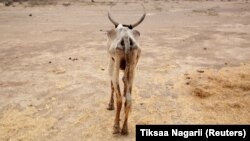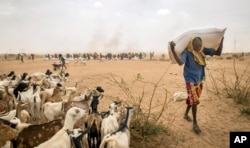The Pacific Ocean is in the midst of an El Niño weather phenomenon that warms the surface of the water, but climate scientists say not for much longer. It is about to be replaced by its sister, La Niña, which comes around every two to five years and cools the surface of the central and eastern Pacific Ocean.
United States Geological Survey (USGS) research scientist Dr. Chris Funk says that, as strange as it sounds, both weather systems can affect long-term weather patterns in a landlocked country half a world away.
If La Niña bumps her brother out of the way, says Funk, “it is quite possible that we might have drought in the southern part of Ethiopia in the fall of next year.”
How is that possible? Think of the weather as a line of stacked dominos — when one falls over, all the rest follow. In this case, La Niña is that first domino, and as it changes the weather in the Pacific, those changes cascade across the entire planet.
Right now, El Niño is part of the reason the northern region of Ethiopia is experiencing its worst drought in decades. But as La Niña takes its place, Funk says those rainfall deficits are likely to move into the southern parts of Ethiopia, extending into the Horn of Africa.
“There are two rainy seasons in the equatorial part of east Africa,” Funk said. “They get rain in the fall — October, November and December — and there is another rainy season in March, April and May. So one of the dangers of La Niña is it can make both of these seasons perform very poorly. That is what happened in 2010 and 2011. So there is concern from a food security perspective [that] we might have two poor rainy seasons in a row.”
Back-to-back droughts in Kenya and Somalia, or a March-June drought in Ethiopia, could cause food and water shortages, hurt hydro-power stations and worsen farming conditions.
Funk's team is working on ways to prepare for the threat of hard times. The group is urging the population to brace for drought-related monetary loss, but also is using high-tech equipment to help farmers and livestock managers find water.
While it may not be possible to stop a drought, scientists are getting better at predicting it and helping those most affected prepare for the worst.











